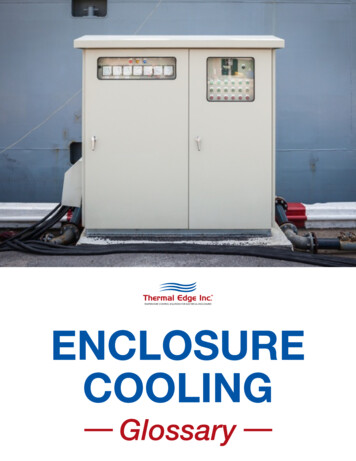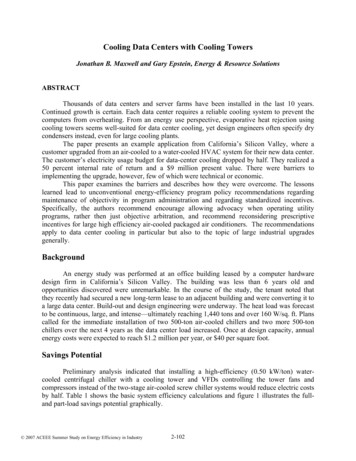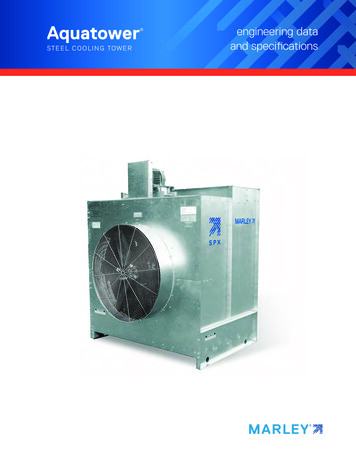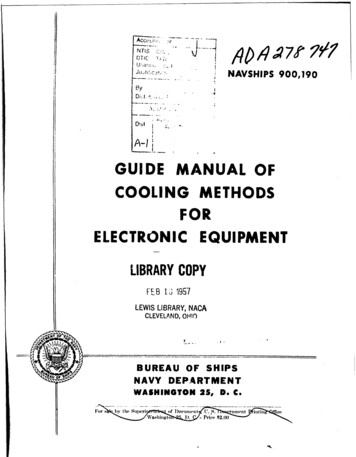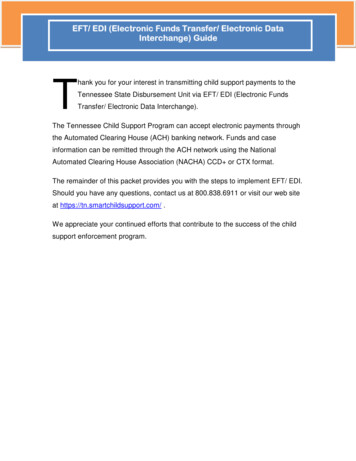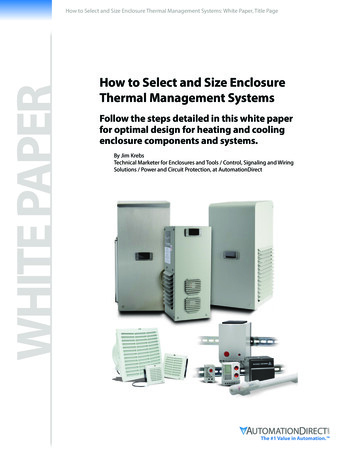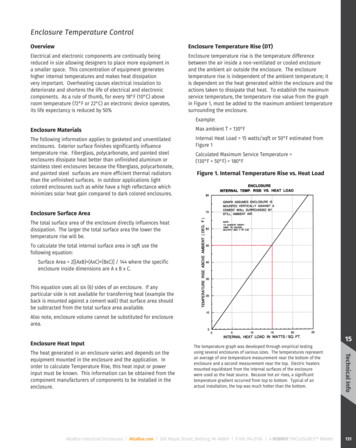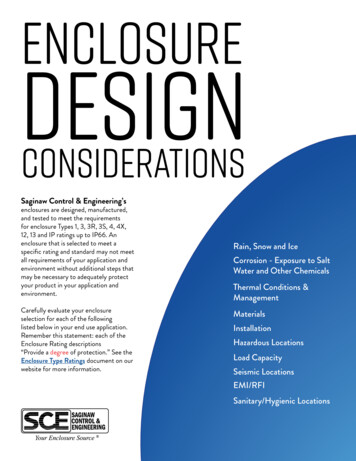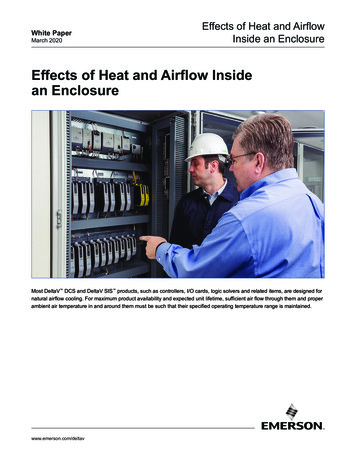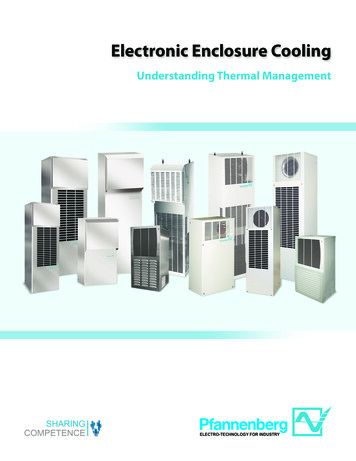
Transcription
Electronic Enclosure CoolingUnderstanding Thermal ManagementELECTRO-TECHNOLOGY FOR INDUSTRY
PFANNENBERG SOLUTIONSForewardHeat inside electronic enclosures is a hazard for production and functional safety that is often underestimated.Today's powerful electronic assemblies and components inside modern machinery and systems are constantlyexposed to the rigors of increasingly higher temperatures. In the event that individual components failureor malfunction, not only will production suffer, but the health and well being of production personnel couldbe endangered.In order to insure a constant level of operational reliability and a long service life for electronic systemsunder difficult ambient conditions, it is absolutely essential to know about the decisive factors involved in airconditioning electronic enclosure.A Preliminary ViewMany control systems in modern electronic equipment are based on semi-conductor components andcomputer technology. These components are being packed in higher density resulting in higher rates of heatdissipation and less natural dissipation through the enclosure surface area.Service life of electronic enclosure componentsStudies have shown that as the temperaturestress increases on these componentstheir life expectancy will decrease (seechart at right). This is characterized bya logarithmic function that is governedby the operating temperature. For thatreason, the manufacturers of such elementsalways quote maximum operatingtemperatures in their technical data. In theevent components run in excess of thesemaximum values, the manufacturers areunable to guarantee functional reliability.Climatic influences can also aggravate the situation. Although this article is primarily concerned withelectronic equipment located on the shop floor, it is also significant as to the location of the system’s finalinstallation (see world climate map below).Average Annual TemperatureThe original scale units are degrees Centigrade,the conversion to Fahrenheit is approximate.
Temperature Changes Within EnclosuresWhat can influence temperature changes within electronic enclosures?An electronic enclosure is nothing more than an enclosed space. As inside a room, there is a higher temperature in andaround the top of the room than in the area around the base and because of this difference a slight airflow occurs callednatural convection. This all takes place without any installed power, simply as a result of natural ambient conditions.If you install a heat-generating component into a smaller area such as a transformer into an electronic enclosure, thetemperature level will rise.Due to the limited heat transmission of the enclosure surfaces, it may nolonger be possible to extract the heat that is produced within the cabinet. Asconsequence, the temperature rises and the difference in temperature insidethe electronic enclosure lessens. If the temperature in the area surroundingthe component has risen to such an extent that it is equal to its maximumoperating temperature, the critical point has been reached.aHOne common heat phenomenon within an enclosure is known as a “hot spot”.Hot spots are areas inside the electronic enclosure that are not involved inthe process of natural convection. This is due to undercuts or installationsthat prevent an exchange of air. However, hot spots mainly form in the regionand around the top of the electronic enclosure. This action is intensified byrise in ambient temperature.inaWDElectronic enclosures should be well sealed at all times. An open area,Schematic diagram of temperaturelarge orifices or a missing electronic enclosure panel can produce avenues fordistribution inside an electronic enclosureexternal heat, dust and humidity into the enclosure. This can be magnifiedif there are other heat sources located in the immediate vicinity of the electronic enclosure.If any of the components inside an enclosure meet their critical point, the only recourse is to open the electronicenclosure. However, this is only a short-term solution, because of the reasons mentioned above.The only true solution now is active cooling by means of a closed-loop air conditioner.Humidity Inside EnclosuresAnother deadly enemy of electronic equipment is humidity. You will always find a certain amount of water dissolved inambient air. The higher the level of humidity within an enclosure, the shorter you can expect the life expectancy to be ofthe components inside.An air conditioner can exert its influence on this by reducing the level of humidity.The operating principle of an air conditioner is to convert cold air into warm air,thereby encouraging the accumulation of condensation inside the air conditionerand dehumidifying the air inside the electronic enclosure therefore reducing thelevel of humidity.Corroded electronic components
Humidity (cont.)For that reason, at the beginning of the cooling process, the air conditioner producesa relatively high amount of condensation, which collected inside the A/C and burnedoff into the atmosphere or released through a condensate drain line. After a few hoursof operation, the humidity inside the electronic enclosure adjusts to a constant level,which is considerably lower than that outside the electronic enclosure.Corroded electronic componentsProper Temperature SettingsA special physical effect is caused by a high degree of fluctuation in ambient temperature. Condensation has beenknown to accumulate on the inside surface of the electronic enclosure (see picture below).If the temperature drops below the dewpoint, humidity condenses on the inside surface of the switch cabinet. Thedewpoint is a term used to express the precipitation of water from the relative humidity. The following diagram showsthe dewpoint line. If the temperature exceeds the limiting curve to the dewpoint line, condensation will accumulate.90100100RelativeHumidity 0510251520Air Temperature T (C)303540Dewpoint Td (F)40Dewpoint Td (C)Air Temperature T (F)5080607040Electronic enclosure with condensationThis is one of the reasons the temperature setting inside the electronic enclosure is still set relatively high at 95 F.(ie typical plant temperature 95 vs office room temperature 75 F). Electronics do not need to be cooled down tohuman comfort levels, but kept below a temperature that prevents degrading of the components. See previous chart.In some situations, the ambient temperature could fall well below the temperature inside the enclosure. In thesesituations a heater in added into the electronic enclosure to prevent condensation. Typically this issue is seen duringoutdoor installations.
PFANNENBERG SOLUTIONSOperational Issues for Air ConditionersSystems in which air conditioners have been installed to air condition electronic enclosures are always subject toenvironmental influences. For that reason, it is difficult for the user to ascertain prior to operation what levels ofambient temperature and humidity he can expect during everyday operation. Calculation is therefore dependenton the quality of the theoretical data provide up front.How an air conditioner works.An electronic enclosure air conditioner is inconspicuous in appearance. Packed inside, though, you will findall the parts necessary to produce cool air. The basics are always the same: there are two circuits, known asinternal and external airflow circuits. The internal circuit cools the inside of the electronic enclosure. This iswhere the thermal energy is extracted from the air inside the electronic enclosure. The vehicle for this processis the coolant in the refrigerant circuit. With the aid of the condenser, the coolant transports the thermalenergy into the external airflow circuit, where the coolant is cooled to release the thermal energy. The processcontinues in a repetitive cycle.Airflow diagrams for side-mounted and top-mounted air conditioners.Important Project ConsiderationsEarly on, during the project-planning phase for your equipment, you should always pay due consideration to thelocation of your air conditioning system. In the case of equipment with a high packing density, it is important to insuresatisfactory airflow in each of the designed enclosure compartments. In addition, a thorough check must be carried outon the ambient conditions in order to be able to take into account all aspects during the calculation process.Correctly sizing an air conditioner requires precise information on the installed power component’s heat dissipation. Itis also important to know how the components are mounted and what type of enclosure is to be used in the installation.Not to be forgotten in this context are the ambient conditions, such as electronic enclosure installation site, dust oremission content in the ambient air, relative humidity and fluctuations in ambient temperatures.Check that air intake and extraction in the external circuit of the air conditioner are satisfactory to insure that thethermal energy can be abducted into the atmosphere in an optimum manner. No installations of any kind should beallowed in front of the air inlet and outlet orifices, whereby we recommend a minimum clearance of approximately 8inches. Any interference of airflow at these points can cause a considerable reduction in performance.
If the airflow volume of components with large-sized built-in fans is greater than that of the cooling system, or if theairflow circuits counteract each other during operation, the refrigeration capacity is considerably reduced and heatpockets can form.A check on connection points is necessary to insure that no interface problems arise during installation.Operation and MaintenanceIn order to insure reliable air conditioning, it is absolutely necessary to pay due attention to the following points.Each and every air conditioner produces condensate, which should be collected in a condensate tray inside the unit withexcess water drained off from the unit through the condensate overflow. Condensate must be extracted from the unit,because otherwise damage may be caused to the electronic equipment.The Future of Cooling UnitsIn the future, cooling will play a more significant role in machine design with four major trends leading the way: Drive Technology – smaller packaging of increased power or greater energy density Control Logic – Increased processing speeds are more sensitive, while creating larger heat dissipation Enclosure Size – Since the systems going into the enclosures are smaller, the enclosure size is naturally reduced Enclosure Sealing – As the standard sealing of enclosures is improved, natural heat dissipation is reducedWith all this being said, it is now more important than ever for machine builders to think of air conditioning early on inthe design process preventing expensive re-works and premature component breakdowns.Written by: Thomas Kreter and Blaine Witt, Pfannenberg Inc. 2010 Pfannenberg Inc.
Calculation is therefore dependent on the quality of the theoretical data provide up front. How an air conditioner works. An electronic enclosure air conditioner is inconspicuous in appearance. Packed inside, though, you will find all the parts necessary to produce cool air. The basics are always the same: there are two circuits, known as internal and external airflow circuits. The internal .


